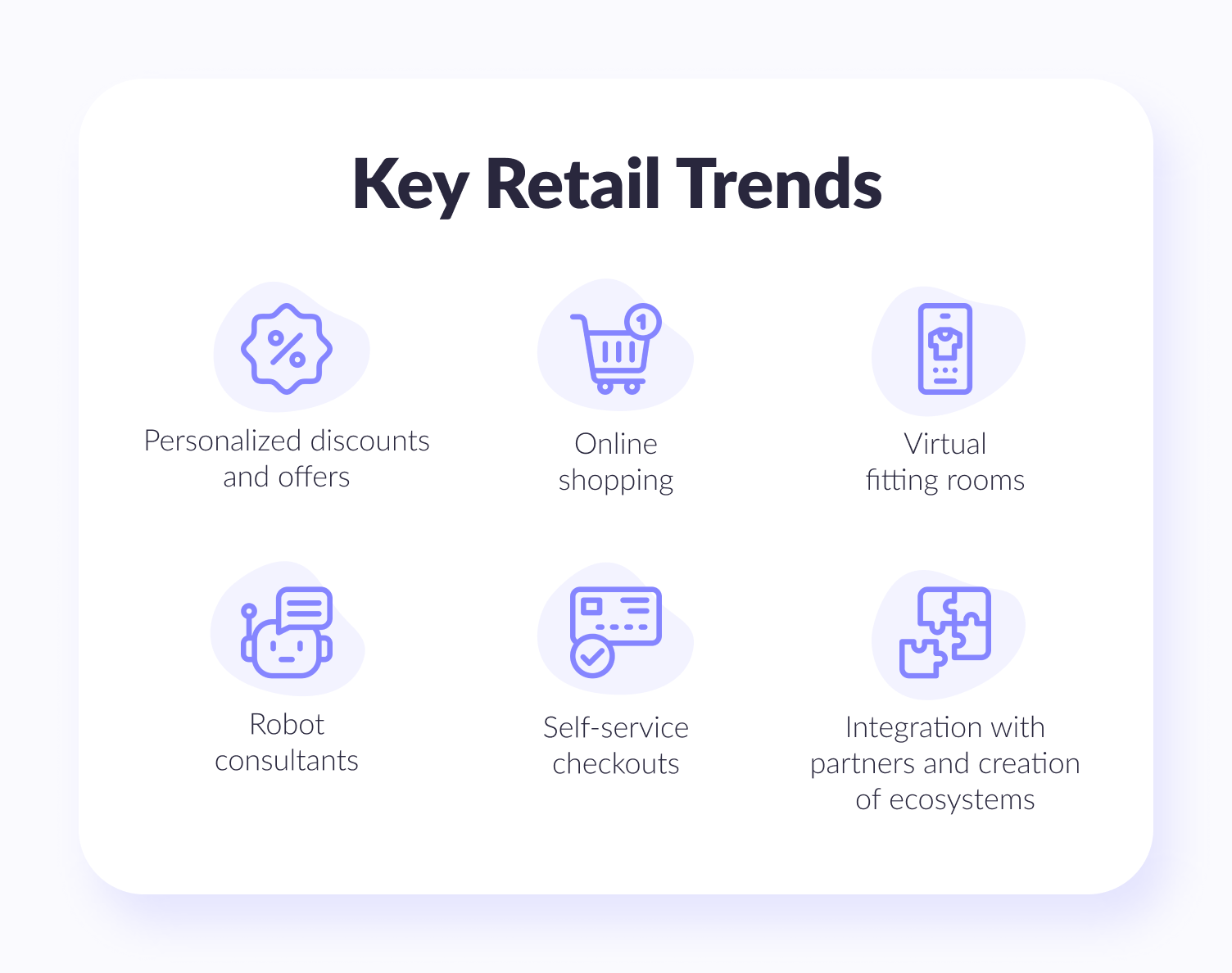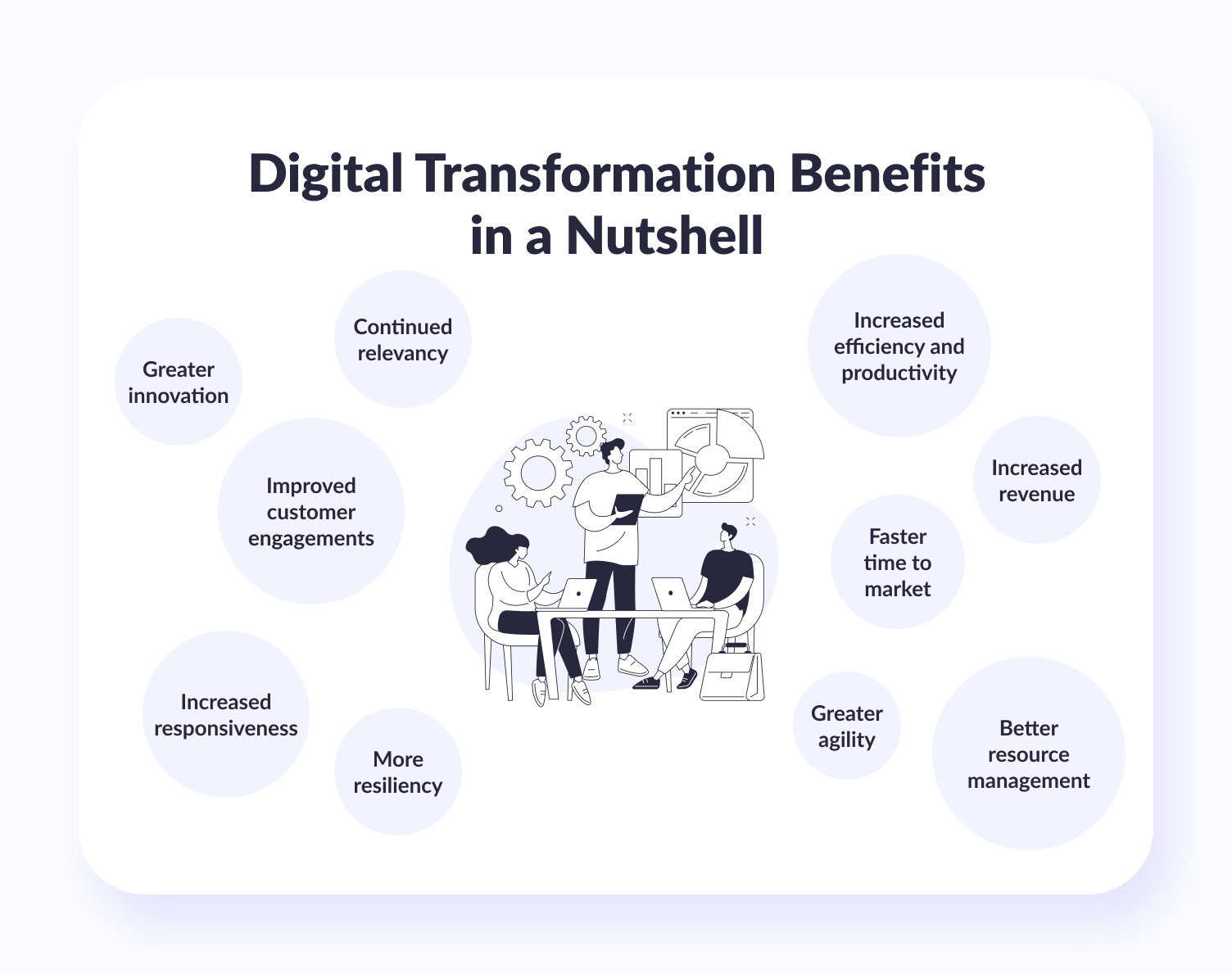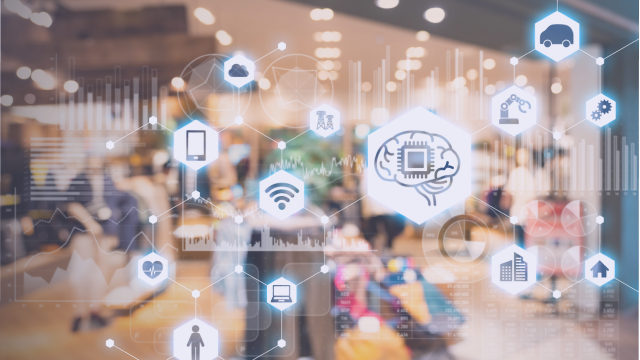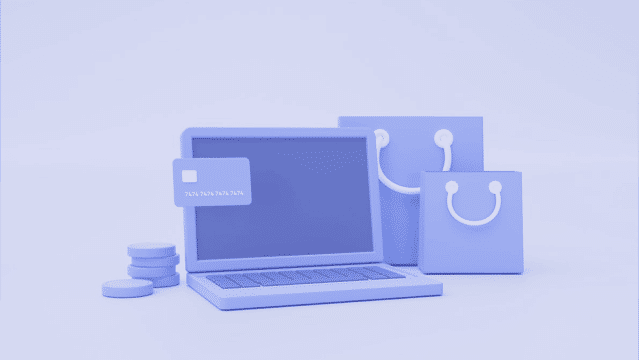- Key Retail Trends
- Pros and Cons of Retail Digitalization
- FacePay: face recognition
- IoT: smart shelves and surveillance cameras
- VR: research in the virtual store
- In-Store Robotics: Consultant Robots
- ESL system: electronic price tags with automatic price adjustment
- Neural network: search for similar products by images
- Conclusion
Technological solutions open up new opportunities for retailers. Large global retailers are constantly looking for new opportunities for contactless payments: payment in mobile applications of stores, payment by QR code and even biometric payment. Over the past year, we have seen an increase in demand for AI solutions for retail: we regularly receive requests from both large chain stores and unique outlets. To simplify the usual processes, AI promotes the personalization of marketing, optimizes offline and online shopping, helping the visitor to make purchases at the point of sale and making the interaction process through the digital platform simple and secure.
According to Juniper Research, by 2023, retailers' spending on AI technologies will increase by $8.4 billion compared to 2019 and reach $12 billion. It is predicted that by this time more than 325 thousand outlets will implement AI technologies. The artificial intelligence market is growing, and retail is one of the active drivers of its growth. Among the main technological trends in retail for 2022, according to Gartner is Generative AI (generative artificial intelligence). It works well with photo, video, sound and text, allowing you to create new forms of creative content that can be used, for example, for a product advertising campaign.
Today we will talk about FacePay, IoT, VR and In-Store Robotics technologies, ESL system, Neural network, which can be found in stores.
In this Article:
Key Retail Trends
Modern companies around the world are investing in digitalization and automation of business processes to create more interesting individual offers, improve online shopping services, make it easier to select products and reduce the busyness of consultants in salerooms.
Personalized discounts and offers
Giving a discount is the main way for a company to attract traffic, including Internet traffic. But if earlier discounts were offered to everyone in a row, now with the help of digitalization, businesses have the opportunity to make individual offers based on a person’s past purchases and their needs. When a person presents a loyalty card at the checkout, the system “remembers” the history of purchases and in the future can offer those products that are of most interest to the consumer. For example, using mailing or push notifications.
Online shopping
Many customers made their first online order from their usual stores only with the onset of the pandemic. The lockdown was delayed, so people had enough time to feel the convenience of choosing and delivering products. Market players know that after the restrictions are lifted, people will not stop ordering products online, so they are constantly working to improve delivery services. For example, medium-sized companies and large businesses have launched a video chat service with an order picker so that the consumer can verify the quality of products and check expiration dates.
Virtual fitting rooms
Clothing sellers install mirror interactive screens that allow you to select any product from the range and immediately see how the clothes look on a person. If everything suits you, you can press a few buttons and pick up your purchase at the checkout. This solution allows the retail outlet to serve more customers, because it is more convenient for them to choose clothes: there is no need to walk through the aisles, wait in line for a fitting room and change clothes.

A real story
Virtual fitting rooms: real case by Geniusee
ind out how implementing new technologies into your business may increase your sales for 20%
Take a lookRobot consultants
To save staff from having to answer the same questions dozens of times a day, businesses are installing robots that can give simple advice. For example, if you can’t find a department with drinks or you need to check the availability of products. Large companies in the US have long been using this technology not only in retail outlets, but also in warehouses: Amazon has 45,000 robots.
Self-service checkouts
Most of the world's major retailers have already installed cash desks that do not have a cashier: the buyer himself scans the barcodes of goods and pays for the purchase with a card. Such cash desks can be equipped with additional solutions, for example, “smart” scales: using a camera, the scales determine the type of product and immediately add it to the receipt.
Integration with partners and creation of ecosystems
Businesses are increasingly entering into partnership contracts and creating ecosystems around the brand in order to sell more and form new distribution channels. For example, when you buy a Samsung TV on the BestBy network, you get a monthly Netflix subscription as a gift.

Pros and cons of retail digitalization
While the introduction of information technology increases business revenue, not everyone perceives the changes positively. Robotization can scare away people of the older age category, who are more accustomed to communicating with a cashier or consultant, rather than listening to the synthetic voice of a robot.
In some cases, digitalization can even hurt, for example, if only the delivery option is available, and the person would like to evaluate the products before buying. Digital retail makes the experience more interesting, but people will still come to shop in person to see the products in real life or get advice from the seller.
Among the most popular problems of retail digitalization, top managers of retail chains name: lack of experience in implementing information technologies, difficulty in estimating the timing and cost of a project, lack of competent IT specialists and inefficient interaction between employees of different departments. Approximately half of the respondents believe that consumers are not yet accustomed to the use of high-tech products.
The transition to artificial intelligence in business is not only about personal offers and robotic consultants. Some technologies increase the revenue of companies, although they are in the shadows.

FacePay: face recognition
The development and creation of a barrier-free environment is the trend of our time. In China, there have long been stores where you can pay using Face ID and similar identification systems. The best results in the face recognition process were achieved by neural networks.
In the United States, FacePay cashless payment technology is gaining popularity. Initially, it developed in the context of a biometric password for a virtual bank card. Today, you can pay in person in the metro and some supermarkets. FacePay is said to be able to recognize faces with over 70% accuracy even when wearing a medical mask. The development of a face recognition system will allow us to actively create stores without cash registers. Stores of a new type will become more convenient and safer for both business and consumers: the use of a face recognition system in them will allow fixing offenders, and a self-service checkout will get rid of a still existing problem, the cashier shortchanged.
IoT: smart shelves and surveillance cameras
In Amazon stores, relatively long ago, they decided to combine the work of the entire store on the principle of "smart home". Based on the architecture of the Internet of things, it fully functions without sellers. The store's cameras are connected to a self-learning neural network. When a visitor takes or returns a product to the shelf, the system captures his action. Entry and exit from the store occurs through the application: the buyer scans a QR code, and the technology identifies him and opens the door. If payment has not been made, the visitor will only be able to exit by pressing the emergency exit button.
VR: research in the virtual store
To determine the best position of products on the shelf, the American company Kellog conducted marketing research in virtual reality. An innovative VR solution based on eye tracker technology allowed the user wearing special glasses to enter the store and see digitized 3D models of goods on the shelves. The development opens up new opportunities for trade marketing and merchandising. With eye-tracking technology, you can test new packaging designs and determine the most successful product display in a "real" store.
https://www.youtube.com/watch?v=meT_FEMeB4w
By the way, the results of the aforementioned study showed that the placement of the company's products on the lower shelves is 18% more effective than on the upper ones.
Best ways to test your users
Not only do trendy technologies matter but user experience as well. Find out how to build best of the best app for user in this article
In-Store Robotics: Consultant Robots
It can be difficult for a buyer to navigate in large retail outlets. This problem was solved by Lowe's, which owns a chain of stores selling home improvement products. The LoweBot robot helps visitors find the right products. He asks the customer simple questions to understand what to find and accompanies him to the shelf. The robot replaces the sales assistant. It can also monitor inventory availability and provide information on items that need to be replenished.
ESL system: electronic price tags with automatic price adjustment
Keeping track of price changes in large retail stores can be difficult. That is why customers continue to find themselves in situations where the cost of a product at the checkout differs from the price on the counter.
The technology of digital price tags allows you to automatically adjust the cost of products after changing the price in the back office, promptly inform customers about discounts and special offers, and also reduce labor resources for sticking price tags on shelves. Online retailers have gone a little further.
In addition to electronic price tags, for example, Amazon uses AI to optimize pricing. AI analyzes demand and competitive offers, taking into account situational marketing: holidays, weather conditions and other factors that affect the cost of the product, and then generates a fair price.
U.S.-based Wise Athena has created a solution based on a transformative AI and machine learning platform that predicts demand with high confidence and determines the best value proposition.
In combination with electronic price tags, cost optimization and demand forecasting technologies, retailers will be able to determine the elasticity of demand, quickly adjust promotions and, as a result, increase revenue. Nielsen analysts claim that even a 5% price difference can increase demand growth in a category by up to 75% compared to competitors.

Neural network: search for similar products by images
According to slyce, 74% of users do not find the products they need using a traditional search engine. Visual search allows customers to make less effort to make the necessary purchase, and the business to increase the number of product views and repeat visits, increasing the average check volume.
The technology works on the basis of a neural network that has been trained on a set of data corresponding to the overall picture of the uploaded image. The neural network selects objects in the picture and analyzes their characteristics: color, shape and other important components. The comparison of the original image with the available products on the site occurs instantly, after which the user is prompted to select relevant options for purchase.
Conclusion
Digitalization of online and offline retail is gradually becoming not a competitive advantage, but a necessity. Reducing the checkout time has a positive effect on shopping habits. It also creates a request for stores of a new format, which, thanks to technological solutions, will make it faster and more convenient to receive the necessary goods and services.
All this gives impetus to the digital development of the environment, bringing it closer to the concept of "smart city". By 2030, generation Z will make up one-third of the entire workforce, which means they will be able to fully realize their purchasing power. The habit of buzzers to make purchases through applications and voice assistants will create the prerequisites for changing the usual CJM at points of sale. In order to retain customers, stores will have to adapt to the new model preferred by the target audience.





















